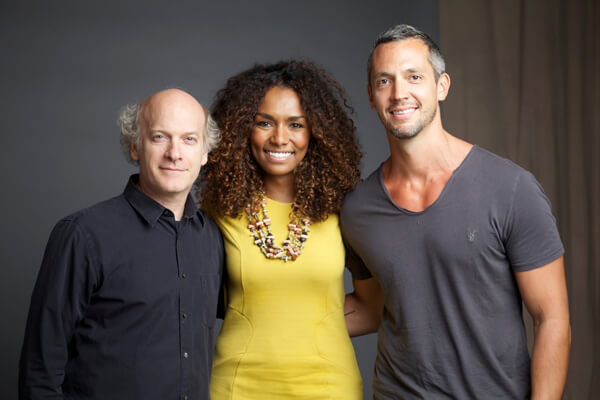A performance scene from Sara Jordenö’s “Kiki.” | SUNDANCE SELECTS
“Kiki” is an uplifting portrait of LGBTQ youth of color who participate in the New York ballroom scene. Director Sara Jordenö focuses on seven subjects, including Twiggy Pucci Garçon, who co-wrote the film; Chi Chi Mizrahi, a fast-talking Latino; Gia Marie Love and Izana “Zariya Mizrahi” Vidal, two very different — but both inspirational and empowered — trans women; and Kenneth “Symba McQueen” Soler-Rios, who is HIV-positive.
Sara Jordenö presents intimate look at seven performers in “Kiki”
Jordenö immerses viewers in the lives of her subjects, showing them dancing along the pier, on subway platforms, and on city streets, and also capturing them in both posed and candid moments. Jordenö chatted with Gay City News about her experiences with the cast and in making “Kiki.”
GARY M. KRAMER: How did you select the seven subjects you interviewed for the film?
SARA JORDENÖ: We wanted to make a very intimate film. We followed people for four years and found those who were willing to open up. That was what determined which seven people we would feature. We became a close-knit group. It was important to have trans women in the film. We were not trying to survey all the individuals in the Kiki scene, but tell their stories and journeys as they grew up in the scene. It was an important time for them, and we were grateful they wanted to share their stories with us.
GMK: “Kiki” is a mix of observational, performance scenes, and interviews, but there are some fantastic still shots that really reveal the subjects. Can you talk about your cinematic approach to portraying the subjects?
SJ: I wanted to do the “screen tests” from the beginning. It became a way for the character to look back at the audience and not be an object or spectacle. I was very worried about the camera objectifying the subjects. I didn’t want it to be just entertainment.
“Kiki” is a serious, political film. We hold these shots so long it becomes a little uncomfortable for the audience. The subjects could hold those long shots, and that was appropriate for their intimacy and the personalities. These shots allowed the subjects to show some vulnerability, as well. I wanted the audience to be affected by them. They won’t let you just enjoy or forget about them.
GMK: What can you say about how you crafted the intimacy you have with your subjects?
SJ: I got very close to the members of the ballroom scene; they embraced me. I was so interested in just conveying these amazing situations. Their practices, for example. I also wanted them to talk about their background and specific things, so It was important to do the interviews.
When we interviewed Gia’s family, she said she didn’t want to be there: “They will give different answers if I am in the room.” Several interviews are of a group or close friends. I wanted to emphasize the close friendships they had.
GMK: The personalities are all very strong, but infectious. I love the scene of Chi Chi buying women’s shoes. Can you talk about your impressions of the subjects?
SJ: Chi Chi is a humorous guy. He’s very comedic. But there is seriousness in him. He didn’t want to talk about his past, but I thought it was important. Chi Chi agreed he would discuss his past because he knew it was a big problem. The subjects see themselves as role models, and so many others in the community share these experiences. Everyone feels their strength when they talk about these things.
Gia and Zariya had to make a decision whether they wanted to show their physical transition on screen, which makes it impossible for them to be stealth, or pass. It’s known that they are trans women, and we had a lot of discussions about that. They feel like they are spokespeople and it was important.
GMK: I also was moved by Symba’s story. What can you say about him?
SJ: We shot Symba for a long time. He was a role model before he became HIV-positive. He was an activist working with HIV prevention before he was diagnosed. Not a lot of people knew of his status, and he decided to convey that story. Symba didn’t want to be a statistic, and that was a disappointment for him. It’s a huge problem, and I think it’s important to see how people are, and it’s better to be open.
This is a community that understands that to survive, they need to talk to each other about their successes and dreams but also their difficult things. They are a talking community, and it’s great to see group discussions about personal stuff for the benefit of the community. They are getting there because of the community and alternative family system they set up; it helps them. They are always saving each other’s lives, from suicide attempts, to getting care after being beaten up. It’s a very warm community.
GMK: There’s a line in the film about exposing Kiki to the mainstream. What are your thoughts about taking a subculture and making it more accepted?
SJ: I think that ballroom has been part of popular culture, but it’s not credited to the people who created that underground culture. It’s important that they get credit. They’ve been a part of New York City culture for decades. The film is transformative, and I feel transformed by it.
We got a question at a screening asking if the film has changed or helped the subjects. I got so angry. It’s the other way around! The viewers are changed. They are going to be transformed because these are people who represent everything that is the opposite of Trump. We need to learn from their resilience!
KIKI | Directed by Sara Jordenö | Sundance Selects | Opens Mar. 1 | IFC Center, 323 Sixth Ave. at W. Third St. | ifccenter.com
































